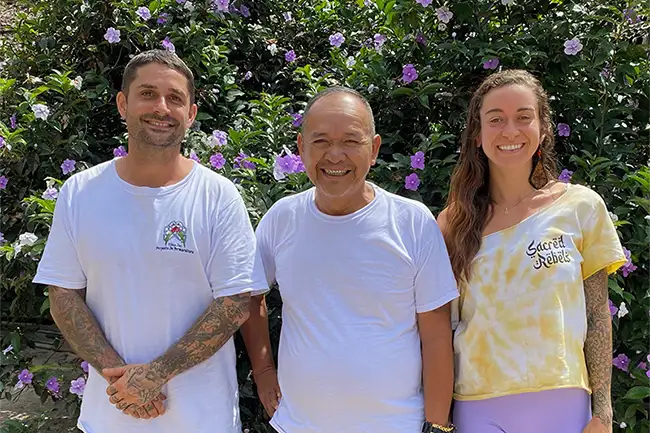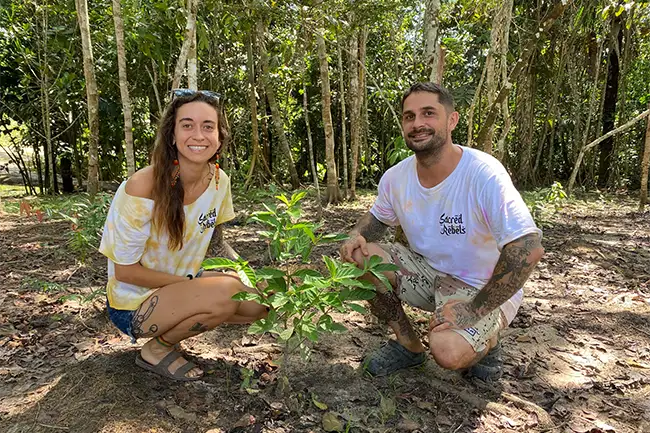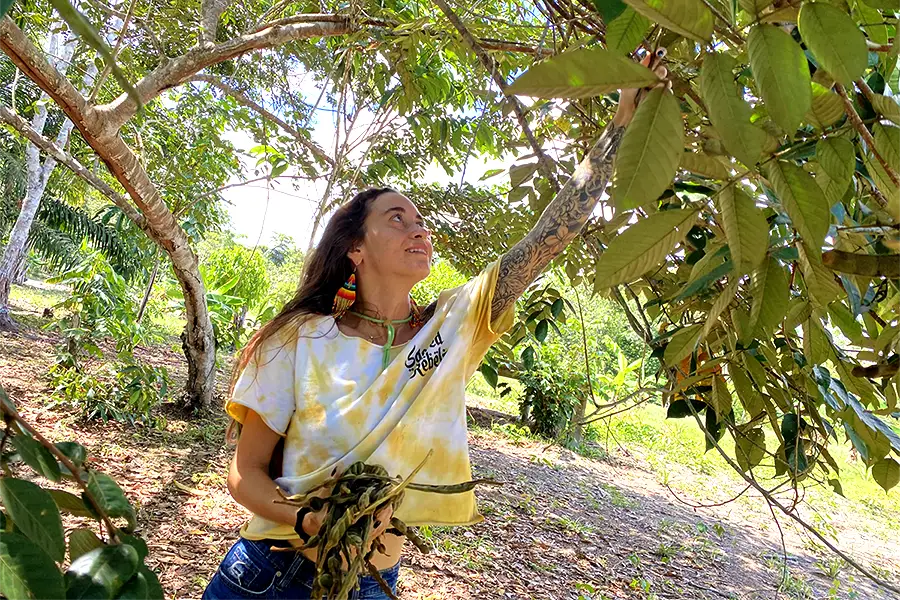As a child, I spent a lot of time outside communing with the beings of the forest floor, the endless sky, the river bank, the garden. My friends and family were lily of the valley, fluffy clouds, chickadees, dandelion, pine, warm rain showers, hydrangea, clover, tiny mushrooms, soft grass, sandy soil. As I grew older, school became more demanding, family and friendships became more complicated, my relationship with nature withered.
The first time I ever tripped, in my early twenties, I watched my (sorely neglected) houseplants grow, blossom and die, grow, blossom and die, in an endless cycle. The beauty made me cry. I recognized how separate I had become from the cycles of nature and our planet. I saw that my suffering was connected to this loss.
Humans have connected with the earth as a way of healing since time immemorial, but it’s only been given a name, “land-based healing,” in recent years. Despite the fact that psychedelic plants and fungi have also been seen for millennia by indigenous communities as just one part of a greater ecosystem—which also includes their territories, ancestors, and all living beings—conversations about how land-based healing and a greater connection to the planet are connected to personal wellbeing are still relatively uncommon in the fast-growing psychedelic industry. But a growing number of people advocating for land-based healing, both inside and outside psychedelics, are seeking to change that.

Land-based healing engages people in a reciprocal relationship with the natural world. In this paradigm, it’s not about what we are getting for ourselves, but what we are giving and receiving in connection with the earth.
N’alag̱a / Ḵ’áw kuuna (Avis O’Brien), a Haida/Kwakwa̱ka̱’wakw artist and land-based cultural empowerment facilitator, found land-based healing after surviving the impacts of Canada’s attempted and ongoing colonial genocide and then turning to substances to cope with the trauma. She now teaches in the medical system, training physicians and medical professionals to reimagine a healthcare system that addresses the root of our problems, rather than just employing band-aid fixes.
“I’ve lived with the spirit of suicide since I was 10 years old. Land-based healing is how I am alive today,” O’Brien says of her practices which, over the years, included sweat lodges, cold water submersion, and cedar brushing. “It’s how I have healed a huge amount of my trauma, how I’ve reclaimed my Indigenous identity that was stolen from me. Land-based healing has helped me to renew those parts of myself, to stay on my path of recovery from heroin addiction and alcohol that I was using to cope.”
READ: The Quest To Preserve Peruvian Torch—By Planting One Million Sacred Cacti

According to O’Brien, land-based healing is for indigenous people by indigenous people, though non-native people may be invited to participate. An Indigenous person whose culture it belongs to must be open to sharing it, and participants should follow their protocols.
How to Grow Shrooms Bundle
Take Both of Our Courses and Save $90!
Land-based healing has not been formally studied through a western medical lens, though numerous studies indicate the tremendous physical benefits from related practices, such as forest bathing. Known as shinrin-yoku in Japanese, forest bathing involves taking in a natural setting through our five senses, opening us up to deeper connection with the natural world.
“Forest bathing reflects how our indigenous languages were born, how our cultures were born,” says O’Brien. “Everything was born from the land, by sitting with the land, listening, opening your senses.”

Land-based healing presents the opportunity for an intentional return to right relationship with the natural world, self, and others, says ecotherapist Jessica Petrone, LPC. “It is a ‘remembering’ of holistic wellness on every level, and how nurturing to and giving to the earth (even as simple as through appreciation and gratitude) is just the same as giving to ourselves,” she says. “The intentional act of giving to and receiving from the land is at the origin of our species although so many cultures and mainstream society have strayed so far from even the acknowledgment of this, let alone the practice of it.”
READ: What Permaculture Teaches Us About Psychedelics

Sapha, a first generation Persian/Canadian, who grew up in Nanaimo, BC and Makena Keahiomakali’i Seymour, a Hawaiian/ American, who was raised in Hawaii and Arizona, are seeking to change that. They both overcame addiction through the intentional combination of plant medicine and holistic practices. Now, along with maestro Ricardo Amaringo, a Shipibo healer and ayahuasquero (person who serves ayahuasca) with more than 20 years of experience, they started Sacred Rebels Recovery, an addiction treatment center about one hour outside of Iquitos, Peru that combines psychedelic ceremony, permaculture, and land-based healing practices as a way of overcoming substance dependence. (The center is unique in that it’s owned and operated by Peruvian Shipibo curanderos and peer-led by a mix of North American indigenous and multi-ethnic people with lived experience of substance dependence, as opposed to many retreat centers in the region which are run by Westerners and hire indigenous healers to work with them.)

“[Ayahuasca] takes you to the core traumas and allows you to really see them. I think that, a lot of the time, in the Western approach, that piece is missing, or it might take years to get to. The medicine can take you right there and allow a different kind of healing to go down,” says Keahiomakali’i Seymour. “For me, combining that with the land-based healing approach has been equally as important. It’s kind of like my version of meditation. In our society, we’re very much in our minds. Working with the land is where I can quiet my mind and step into my body a bit more. Something really magical happens, at least within me. It’s where I go to find answers and guidance.”
“Trauma lives in the nervous system; it’s not cognitive,” says O’Brien about combining land-based healing and psychedelic ceremony. “It lives in the body, and it needs a place to be released. You can’t talk your way out of it— that’s where psychedelics come in, allowing you to access where those traumas are stored in the body. When you reach those wounds, you need a place to let them go, and land has the ability to release traumatic memory that gets stored in the body. I know this from lived experience. The land has taken from me the things that no longer serve me.”
O’Brien also sees healing potential in cultivating and eating the food and medicine grown from the land. “A lot of the food that we eat is toxic, so growing food is wellness. When I eat salmon that comes from rivers that my ancestors have eaten since time immemorial, that’s wellness.”

Sacred Rebels is collaborating with the local indigenous community to create access to essential food items and gainful employment for residents of the village Llanchama (pronounced “yawn-chama”). Their long-term intention is to nurture systems that support food sovereignty for locals in the area, and to cultivate food forests with native foods and medicines to nourish the people who live there. They are cultivating native medicinal plants such as chacruna, ayahuasca, bobinsana, and more, as well as working on sustainable and regenerative systems. According to Sapha, the land used to be a farm 20 years ago, probably for animal agriculture, as a dam was put across a naturally-existing pond there. They have restored it to its natural state.
Sacred Rebels is now considering a permaculture project for the pond. Gamitana, a large piranha that resembles a bass, is a popular food source that has been depleted due to commercial overfishing and drought as a result of climate change. Universidad Nacional de la Amazonía, a bio-pharma agricultural technical university focusing on ecological conservation and plant science, may collaborate with Sacred Rebels Recovery to raise a few thousand fish in the pond, then introduce them into natural habitats to replenish the population. Some that reach full maturity could be harvested and offered to the local community as food. The revenue generated from treating people at Sacred Rebels Recovery will go into continuing to advance the permaculture operations, plant more trees, and do more community development. They are also looking into what it would take to build water towers for the village Llanchama.

“I find that there is such a beautiful and supportive relationship between working with psychedelics and communion with nature, and in my experience the combination of the two is exponentially profound,” says Petrone. “Through my own experiences and through the sharings of others, one common thread I have witnessed that weaves these two worlds together is through working with psychedelics and plant/fungi medicines, most individuals feel their innate relationship to and appreciation for the natural work expand and deepen.”

DoubleBlind is a trusted resource for news, evidence-based education, and reporting on psychedelics. We work with leading medical professionals, scientific researchers, journalists, mycologists, indigenous stewards, and cultural pioneers. Read about our editorial policy and fact-checking process here.

DoubleBlind Magazine does not encourage or condone any illegal activities, including but not limited to the use of illegal substances. We do not provide mental health, clinical, or medical services. We are not a substitute for medical, psychological, or psychiatric diagnosis, treatment, or advice. If you are in a crisis or if you or any other person may be in danger or experiencing a mental health emergency, immediately call 911 or your local emergency resources. If you are considering suicide, please call 988 to connect with the National Suicide Prevention Lifeline.



